Axiomatic Design of a Test Artifact for PBF-LM Machine Capability Monitoring †
Abstract
:1. Introduction
2. Analysis of the NIST Test Artifact
2.1. Description of Characteristics and Main Features
2.2. AD Analysis of NIST Test Artifact
- −
- CN1. Assess overall machine capabilities through the realization of a test artifact to compare multiple printed materials using multiple AM technologies and test the limitations of the system (regardless of the specific additive manufacturing technology);
- −
- CN2. The test artifact shall have as many features as possible to maximize the information content per system inspected;
- −
- CN3. Test artifact features shall be feasible for all the possible additive manufacturing commercial systems available (without any constraints related to additive manufacturing technology).
- The matrix is neither diagonal nor square, so the design is coupled;
- The use of certain features (such as bulk material) makes features not independent.
3. Analysis of the New Test Artifact
3.1. CNs Review
- CN1. Evaluate machine capability assessment for a periodic performance check;
- CN2. Performance check performed fast;
- CN3. Performance check performed cheaply;
- CN4. Results coming from the check robust and reliable;
- CN5. Same performance check among machines and materials with homogeneous characteristics;
- CN6 Performance check safe for those who carry it out.
3.2. FRs Definition and Redesign Using AD
- CN6 shall not be considered an FR. It shall be considered a non-Functional Requirement (nFR) instead;
- CN2 and CN3 lead to FRs that will not satisfy the Independence Axiom because of their very nature. For this reason, in the following AD analysis, we considered speed as an actual FR and cost as a Selection Criteria (SC);
- CN5 represents more of a constraint than an actual FR. Therefore, it will be considered as such.
- FR1. Produce the test artifact in less than 8 h.
- FR2. Analyze the test artifact in less than 12 h.
- FR3. Deliver results with measure accuracy below 10 microns in the whole working space.
3.3. Resulting Artifact Design and Discussion
- Material shrinkages during the solidification, which creates residual stress.
- Beam offset compensation.
- Small enough to make shrinkage effects negligible in their diameter.
- Big enough to avoid being damaged by the re-coater during the printing processing.
4. Experimental Validation
5. Conclusions
- An uncoupled design matrix was obtained through better identification of the parameters used to tune the process.
- The artifact building time has been reduced by 90% compared to the NIST one (FR1), and the inspection time has changed from 16 h to 8 h (FR2).
- Allows the reliable identification of the beam offset and the scaling factor (FR3).
- Assess the performance all over the building platform (FR3.4).
Author Contributions
Funding
Data Availability Statement
Conflicts of Interest
References
- DebRoy, T.; Wei, H.; Zuback, J.; Mukherjee, T.; Elmer, J.; Milewski, J.; Beese, A.; Wilson-Heid, A.; De, A.; Zhang, W. Additive Manufacturing of Metallic Components—Process, Structure and Properties. Prog. Mater. Sci. 2018, 92, 112–224. [Google Scholar] [CrossRef]
- Sames, W.; List, F.; Pannala, S.; Dehoff, R.; Babu, S. The Metallurgy and Processing Science of Metal Additive Manufacturing. Int. Mater. Rev. 2016, 61, 315–360. [Google Scholar] [CrossRef]
- Frazier, W.E. Metal Additive Manufacturing: A Review. J. Mater. Eng. Perform. 2014, 23, 1917–1928. [Google Scholar] [CrossRef]
- Ngo, T.D.; Kashani, A.; Imbalzano, G.; Nguyen, K.T.Q.; Hui, D. Additive manufacturing (3D printing): A review of materials, methods, applications and challanges. Compos. Part B 2018, 143, 172–196. [Google Scholar] [CrossRef]
- Zhang, Y.; Wu, L.; Guo, X.; Kane, S.; Deng, Y.; Jung, Y.G.; Lee, J.Y.; Zhang, J. Additive manufacturing of metallic materials: A review. J. Mater. Eng. Perform. 2018, 27, 1–13. [Google Scholar] [CrossRef]
- Bourell, D.; Kruth, J.P.; Leu, M.; Levy, G.; Rosen, D.; Beese, A.M.; Clare, A. Materials for Additive Manufacturing. CIRP Ann. Manuf. Technol. 2017, 66, 659–681. [Google Scholar] [CrossRef]
- Achillas, C.; Tzetzis, D.; Raimondo, M.O. Alternative production strategies based on the comparison of additive and traditional manufacturing technologies. Int. J. Prod. Res. 2017, 55, 3497–3509. [Google Scholar] [CrossRef]
- Ciappi, A.; Giorgetti, A.; Ceccanti, F.; Canegallo, G. Technological and economical consideration for turbine blade tip restoration through metal deposition technologies. Proc. Inst. Mech. Eng. Part C J. Mech. Eng. Sci. 2021, 235, 1741–1758. [Google Scholar] [CrossRef]
- Kim, H.; Lin, Y.; Tseng, T.L.B. A review on quality control in additive manufacturing. Rapid Prototyp. J. 2018, 24, 645–669. [Google Scholar] [CrossRef]
- Mandolini, M.; Pradel, P.; Cicconi, P. Design for Additive Manufacturing: Methods and Tools. Appl. Sci. 2022, 12, 6548. [Google Scholar] [CrossRef]
- Ceccanti, F.; Giorgetti, A.; Citti, P. A support structure design strategy for laser powder bed fused parts. Procedia Struct. Integr. 2019, 24, 667–679. [Google Scholar] [CrossRef]
- Mostafaei, A.; Zhao, C.; He, Y.; Ghiaasiaan, S.R.; Shi, B.; Shao, S.; Shamsaei, N.; Wu, Z.; Kouraytem, N.; Sun, T.; et al. Defects and anomalies in powder bed fusion metal additive manufacturing. Curr. Opin. Solid State Mater. Sci. 2022, 26, 100974. [Google Scholar] [CrossRef]
- Giorgetti, A.; Baldi, N.; Palladino, M.; Ceccanti, F.; Arcidiacono, G.; Citti, P. A Method to Optimise Parameters Development in L-PBF Based on Single and Multitracks Analysis: A Case Study on Inconel 718 Alloy. Metals 2023, 13, 306. [Google Scholar] [CrossRef]
- Yadroitsava, I.; Els, J.; Booysen, G.; Yadroitsev, I. Peculiarities of single track formation from Ti6AL4V alloy at different laser power densities by selective laser melting. S. Afr. J. Ind. Eng. 2015, 26, 86–95. [Google Scholar] [CrossRef]
- Zheng, H.; Wang, Y.; Xie, Y.; Yang, S.; Hou, R.; Ge, Y.; Lang, L.; Gong, S.; Li, H. Observation of Vapor Plume Behavior and Process Stability at Single-Track and Multi-Track Levels in Laser Powder Bed Fusion Regime. Metals 2021, 11, 937. [Google Scholar] [CrossRef]
- Dong, Z.; Liu, Y.; Wen, W.; Ge, J.; Liang, J. Effect of Hatch Spacing on Melt Pool and As-built Quality During Selective Laser Melting of Stainless Steel: Modeling and Experimental Approaches. Materials 2019, 12, 50. [Google Scholar] [CrossRef]
- Caiazzo, F.; Alfieri, V.; Casalino, G. On the Relevance of Volumetric Energy Density in the Investigation of Inconel 718 Laser powder Bed Fusion. Materials 2020, 13, 538. [Google Scholar] [CrossRef]
- Johnson, L.; Mahmoudi, M.; Zhang, B.; Seede, R.; Huang, X.; Maier, J.T.; Maier, H.J.; Karaman, I.; Elwany, A.; Arróyave, R. Assessing printability maps in additive manufacturing of metal alloys. Acta Mater. 2019, 176, 199–210. [Google Scholar] [CrossRef]
- Tenbrock, C.; Fischer, F.G.; Wissenbach, K.; Schleifenbaum, J.H.; Wagenblast, P.; Meiners, W.; Wagner, J. Influence of keyhole and conduction mode melting for top-hat shaped beam profiles in laser powder bed fusion. J. Mater. Process. Technol. 2020, 278, 116514. [Google Scholar] [CrossRef]
- Guo, Y.; Jia, L.; Kong, B.; Wang, N.; Zhang, H. Single track and single layer formation in selective laser melting of niobium solid solution alloy. Chin. J. Aeronaut. 2018, 31, 860–866. [Google Scholar] [CrossRef]
- Mukherjee, T.; DebRoy, T. Mitigation of lack of fusion defects in powder bed fusion additive manufacturing. J. Manuf. Process. 2018, 36, 442–449. [Google Scholar] [CrossRef]
- Ma, H.Y.; Wang, J.C.; Qin, P.; Liu, Y.J.; Chen, L.Y.; Wang, L.Q.; Zhang, L.C. Advances in Additively Manufactured Titanium Alloys by Powder Bed Fusion and Directed Energy Deposition: Microstructure, Defects, and Mechanical Behavior. J. Mater. Sci. Technol. 2024, 183, 32–62. [Google Scholar] [CrossRef]
- Snow, Z.; Scime, L.; Ziabari, A.; Fisher, B.; Paquit, V. Scalable in situ non-destructive evaluation of additively manufactured components using process monitoring, sensor fusion, and machine learning. Addit. Manuf. 2023, 78, 103817. [Google Scholar] [CrossRef]
- Wang, J.; Zhu, R.; Liu, Y.; Zhang, L. Understanding melt pool characteristics in laser powder bed fusion: An overview of single-and multi-track melt pools for process optimization. Adv. Powder Mater. 2023, 2, 100137. [Google Scholar] [CrossRef]
- Feng, S.; Chen, Z.; Bircher, B.; Ji, Z.; Nyborg, L.; Bigot, S. Predicting laser powder bed fusion defects through in-process monitoring data and machine learning. Mater. Des. 2022, 222, 111115. [Google Scholar] [CrossRef]
- Land, W.S.I.; Zhang, B.; Davies, A. In-Situ Metrology System for Laser Powder Bed Fusion Additive Process. Procedia Manuf. 2015, 1, 393–403. [Google Scholar] [CrossRef]
- Bidare, P.; Maier, R.; Beck, R.; Shephard, J.; Moore, A. An Open-Architecture Metal Powder Bed Fusion System for In-Situ Process Measurements. Addit. Manuf. 2017, 16, 177–185. [Google Scholar] [CrossRef]
- Umaras, E.; Tsuzuki, M.S.G. Additive Manufacturing-Considerations on Geometric Accuracy and Factors of Influence. IFAC PapersOnLine 2017, 50, 14940–14945. [Google Scholar] [CrossRef]
- Ortega, N.; Martinez, S.; Cerrillo, I.; Lamikiz, A.; Ukar, E. Computed Tomography Approach to Quality Control of the Inconel 718 Components Obtained by Additive Manufacturing (SLM). Procedia Manuf. 2017, 13, 116–123. [Google Scholar] [CrossRef]
- Abdelrahman, M.; Reutzel, E.W.; Nassar, A.R.; Starr, T.L. Flaw Detection in Powder Bed Fusion Using Optical Imagining. Addit. Manuf. 2017, 15, 1–11. [Google Scholar]
- Scime, L.; Beuth, J. Anomaly Detection and Classification in a Laser Powder Bed Additive Manufacturing Process Using a Trained Computer Vision Algorithm. Addit. Manuf. 2018, 19, 114–126. [Google Scholar] [CrossRef]
- Krauss, H.; Zeugner, T.; Zaeh, M.F. Layerwise Monitoring of the Selective Laser Melting Process by Thermography. Phys. Procedia 2014, 56, 64–71. [Google Scholar] [CrossRef]
- Malekipour, E.; El-Mounayri, H. Common defects and contributing parameters in powder bed fusion AM process and their classification for online monitoring and control: A review. Int. J. Adv. Manuf. Technol. 2018, 95, 527–550. [Google Scholar] [CrossRef]
- Fahad, M.; Hopkinson, N. Evaluation and comparison of geometrical accuracy of parts produced by sintering-based additive manufacturing processes. Int. J. Adv. Manuf. Technol. 2017, 88, 3389–3394. [Google Scholar] [CrossRef]
- Ye, D.; Hong, G.S.; Zhang, Y.; Zhu, K.; Fuh, J.Y.H. Defect detection in selective laser melting technology by acoustic signals with deep belief networks. Int. J. Adv. Manuf. Technol. 2018, 96, 2791–2801. [Google Scholar] [CrossRef]
- Delgado, J.; Ciurana, J.; Rodriguez, C. Influence of process parameters on part quality and mechanical properties for DMLS and SLM with iron-based materials. Int. J. Adv. Manuf. Technol. 2012, 60, 601–610. [Google Scholar] [CrossRef]
- Yakout, M.; Cadamuro, A.; Elbestawi, M.A.; Veldhuis, S.C. The selection of process parameters in additive manufacturing for aerospace alloys. Int. J. Adv. Manuf. Technol. 2017, 92, 2081–2098. [Google Scholar] [CrossRef]
- Rebaioli, L.; Fassi, I. A review on benchmark artifacts for evaluating the geometrical performance of additive manufacturing processes. Int. J. Adv. Manuf. Technol. 2017, 5–8, 2571–2598. [Google Scholar] [CrossRef]
- Taylor, H.C.; Garibay, E.A.; Wicker, R.B. Toward a common laser powder bed fusion qualification test artifact. Addit. Manuf. 2021, 39, 101803. [Google Scholar] [CrossRef]
- Dimitrov, D.; Van Wijck, W.; Schreve, K.; De Beer, N.; Meijer, J. An investigation of the capability profile of the three dimensional printing process with an emphasis on the achievable accuracy. CIRP Ann. Manuf. Technol. 2003, 52, 189–192. [Google Scholar] [CrossRef]
- Scaravetti, D.; Dubois, P.; Duchamp, R. Qualification of rapid prototyping tools: Proposition of a procedure and a test part. Int. J. Adv. Manuf. Technol. 2008, 38, 683–690. [Google Scholar] [CrossRef]
- Brajlih, T.; Valentan, B.; Balic, J.; Drstvensek, I. Speed and accuracy evaluation of additive manufacturing machines. Rapid Prototyp. J. 2011, 17, 64–75. [Google Scholar] [CrossRef]
- Mahesh, M.; Wong, Y.S.; Fuh, J.Y.H.; Loh, H.T. Benchmarking for comparative evaluation of RP systems and processes. Rapid Prototyp. J. 2004, 10, 123–135. [Google Scholar] [CrossRef]
- Lopes, A.J.; Perez, M.A.; Espalin, D.; Wicker, R.B. Comparison of ranking models to evaluate desktop 3D printers in a growing market. Addit. Manuf. 2020, 35, 101291. [Google Scholar] [CrossRef]
- Ghany, K.A.; Moustafa, S.F. Comparison between the products of four RPM systems for metals. Rapid Prototyp. J. 2006, 12, 86–94. [Google Scholar] [CrossRef]
- Moylan, S.; Slotwinski, J.; Cooke, M.; Jurrens, K.; Alkan Donme, M. Proposal for a standardized test artifact for additive. In Solid Freeform Fabrication Symposium; University of Texas: Austin, TX, USA, 2012; pp. 902–920. [Google Scholar]
- Maurer, O.; Herter, F.; Bähre, D. Tolerancing the laser powder bed fusion process based on machine capability measures with the aim of process control. J. Manuf. Process. 2022, 80, 659–665. [Google Scholar] [CrossRef]
- Asnafi, N. Application of laser-based powder bed fusion for direct metal tooling. Metals 2021, 11, 458. [Google Scholar] [CrossRef]
- Moylan, S.; Slotwinski, J.; Cooke, A.; Jurrens, K.; Donmez, M.A. An Additive Manufacturing Test Artifact. J. Res. Natl. Inst. Stand. Technol. 2014, 119, 429–459. [Google Scholar] [CrossRef]
- ISO/ASTM 52941; Additive Manufacturing—System Performance and Reliability—Acceptance Tests for Laser Metal Powder-bed Fusion Machines for Metallic Materials for Aerospace Application. ASTM International: Conshohocken, PA, USA, 2020.
- ISO/ASTM 52902; Additive Manufacturing—Test Artifacts—Geometric Capability Assessment of Additive Manufacturing Systems. ASTM International: Conshohocken, PA, USA, 2019.
- Moshiri, M.; Tosello, G.; Mohanty, S. A new design for an extensive benchmarking of additive manufacturing machines. In Proceedings of the 18th International Conference of the European Society for Precision Engineering and Nanotechnology (Euspen 18), Venice, Italy, 4–8 June 2018. [Google Scholar]
- Moshiri, M.; Candeo, S.; Carmignato, S.; Mohanty, S.; Tosello, G. Benchmarking of Laser Powder Bed Fusion Machines. J. Manuf. Mater. Process. 2019, 3, 85. [Google Scholar] [CrossRef]
- Suh, N.P.; Suh, R. The Principles of Design; Oxford University Press: Oxford, UK, 1990. [Google Scholar]
- Coelho, A.M.G.; Mourão, A.J.F. Axiomatic design as support for decision-making in a design for manufacturing context: A case study. Int. J. Prod. Econ. 2007, 1–2, 81–89. [Google Scholar] [CrossRef]
- Brown, C.A. Axiomatic Design Applied to a Practical Example of the Integrity of Shaft Surfaces for Rotating Lip Seals. Procedia Eng. 2011, 19, 53–59. [Google Scholar] [CrossRef]
- Arcidiacono, G.; Matt, D.T.; Rauch, E. Axiomatic Design of a Framework for the Comprehensive Optimization of Patient Flows in Hospitals. J. Healthc. Eng. 2017, 2017, 2309265. [Google Scholar] [CrossRef]
- Arcidiacono, G.; Molon, M.; Nuzzi, S.; Placidoli, P. Improving Reliability of a fire-fighting pump set with Axiomatic Design. MATEC Web Conf. 2017, 127, 01014. [Google Scholar] [CrossRef]
- Girgenti, A.; Citti, P.; Delogu, M. A novel approach for axiomatic-based design for the environment. In Axiomatic Design in Large Systems; Farid, A., Suh, N., Eds.; Springer: Cham, Switzerland, 2016; pp. 131–148. [Google Scholar] [CrossRef]
- Sölvason, G.Ó.; Foley, J.T. Low-cost spectrometer for icelandic chemistry education. Procedia CIRP 2015, 34, 156–161. [Google Scholar] [CrossRef]
- Foley, J.T.; Harardóttir, S. Creative axiomatic design. Procedia CIRP 2016, 50, 240–245. [Google Scholar] [CrossRef]
- Monti, C.; Giorgetti, A.; Girgenti, A. An Axiomatic Design Approach for a Motorcycle Steering Damper. Procedia CIRP 2015, 34, 150–155. [Google Scholar] [CrossRef]
- Wang, Y.; Liu, A. Student’s Axiomatic Design Application Example of Battery Thermal Controller for High Altitude Balloon. MATEC Web Conf. 2018, 223, 01017. [Google Scholar] [CrossRef]
- Iino, K.; Arruti, A.; Nakao, M. Axiomatic Design Aspect of a Braking System Redesign. MATEC Web Conf. 2017, 127, 01003. [Google Scholar] [CrossRef]
- Bahadir, M.C.; Satoglu, S.I. A novel robot arm selection methodology based on axiomatic design principles. Int. J. Adv. Manuf. Technol. 2014, 71, 2043–2057. [Google Scholar] [CrossRef]
- Bang, I.C.; Heo, G. An axiomatic design approach in development of nanofluid coolants. Appl. Therm. Eng. 2009, 29, 75–90. [Google Scholar] [CrossRef]
- Giorgetti, A.; Anselmi, M.; Scatena, A. Improvement of the Test Equipment for a Stress Corrosion Lab through the Axiomatic Design. Procedia CIRP 2015, 34, 162–167. [Google Scholar] [CrossRef]
- Giorgetti, A.; Citti, P.; Romanelli, M. Development of a Custom Software for Processing the Stress Corrosion Experimental Data through Axiomatic Design. Procedia CIRP 2015, 34, 250–255. [Google Scholar] [CrossRef]
- Arcidiacono, G.; Brown, C.; Bucciarelli, L.; Melosi, F. Axiomatic Design of Production Systems for Performance Improvement: A Project Identification and Prioritisation Model. In Axiomatic Design in Large Systems; Farid, A., Suh, N., Eds.; Springer: Cham, Switzerland, 2016; pp. 251–262. [Google Scholar] [CrossRef]
- Suh, N.P. Axiomatic Design: ADVANCES and Applications; Oxford University Press: New York, NY, USA, 2001. [Google Scholar]
- Suh, N.P. Complexity: Theory and Applications; Oxford University Press: Oxford, UK, 2005. [Google Scholar]
- Suh, N.P.; Cavique, M.; Foley, J.T. Design Engineering and Science; Springer Nature: Berlin/Heidelberg, Germany, 2021. [Google Scholar]
- Giorgetti, A.; Ceccanti, F.; Citti, P.; Ciappi, A.; Arcidiacono, G. Axiomatic Design of Test Artifact for Laser Powder Bed Fusion Machine Capability Assessment. MATEC Web Conf. 2019, 301, 00006. [Google Scholar] [CrossRef]
- Thompson, M.K. A Classification of Procedural Errors in the Definition of Functional Requirements in Axiomatic Design Theory. In Proceedings of the 7th International Conference on Axiomatic Design (ICAD’13), Worcester, MA, USA, 27–28 June 2013. [Google Scholar]
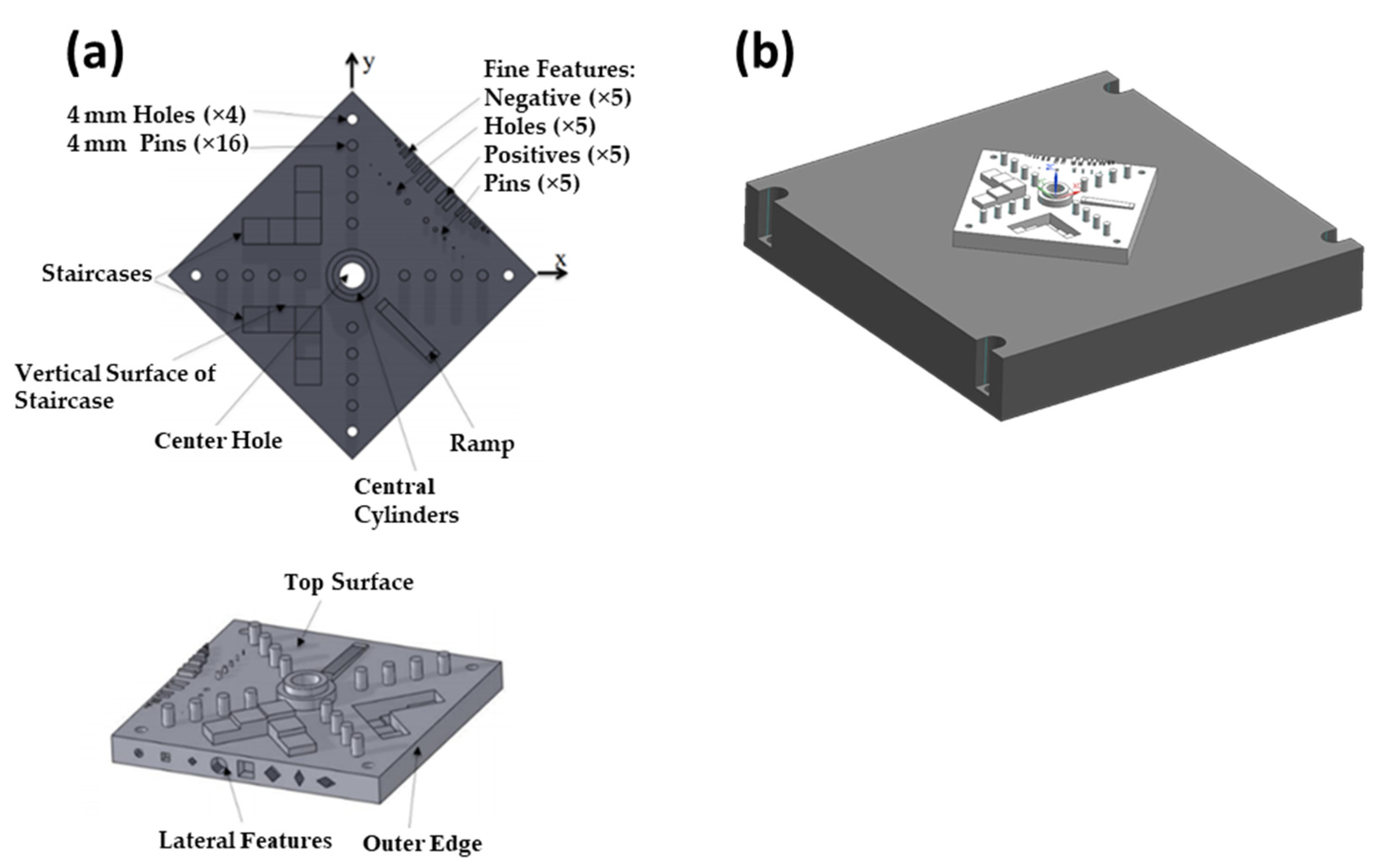

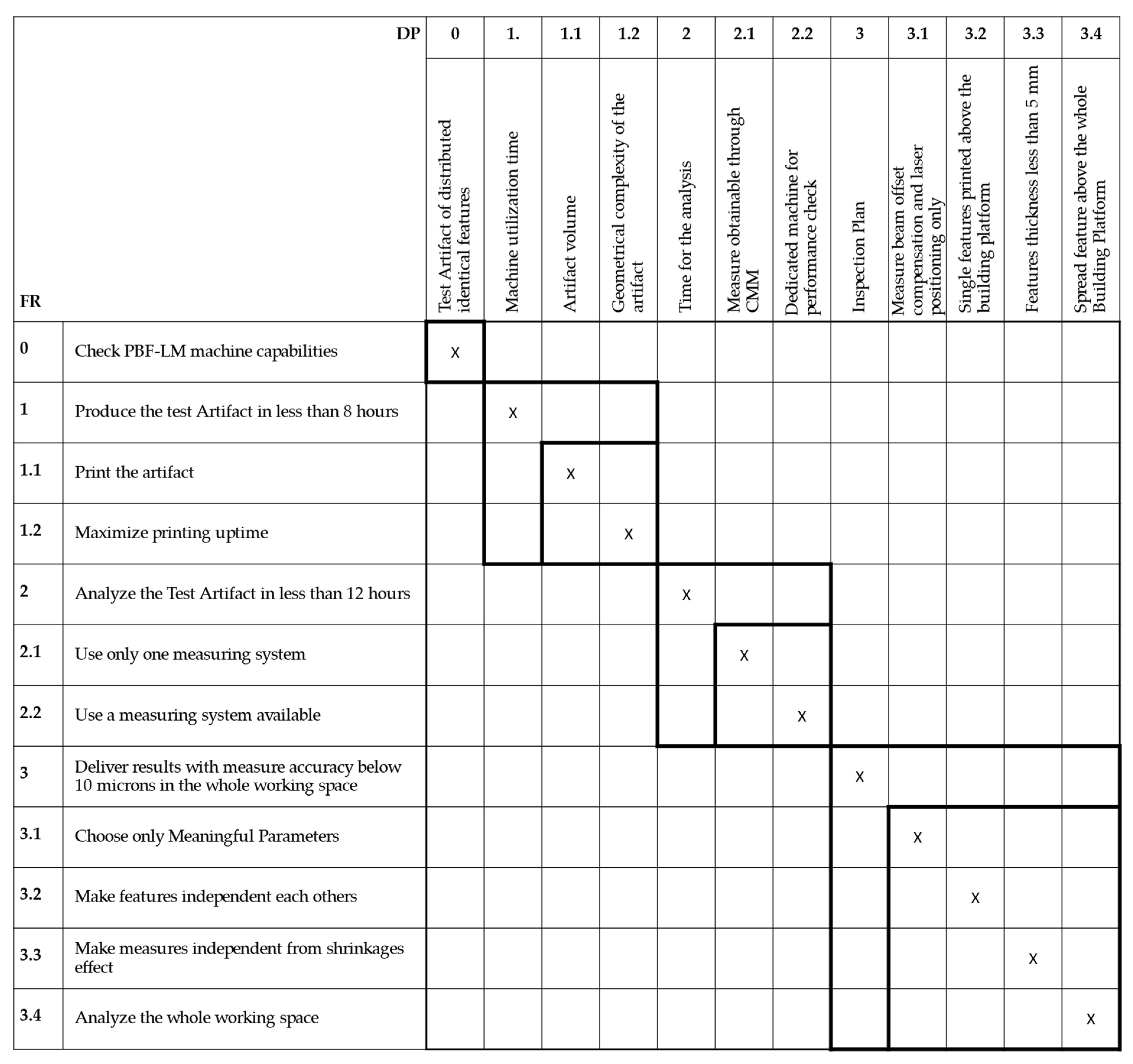
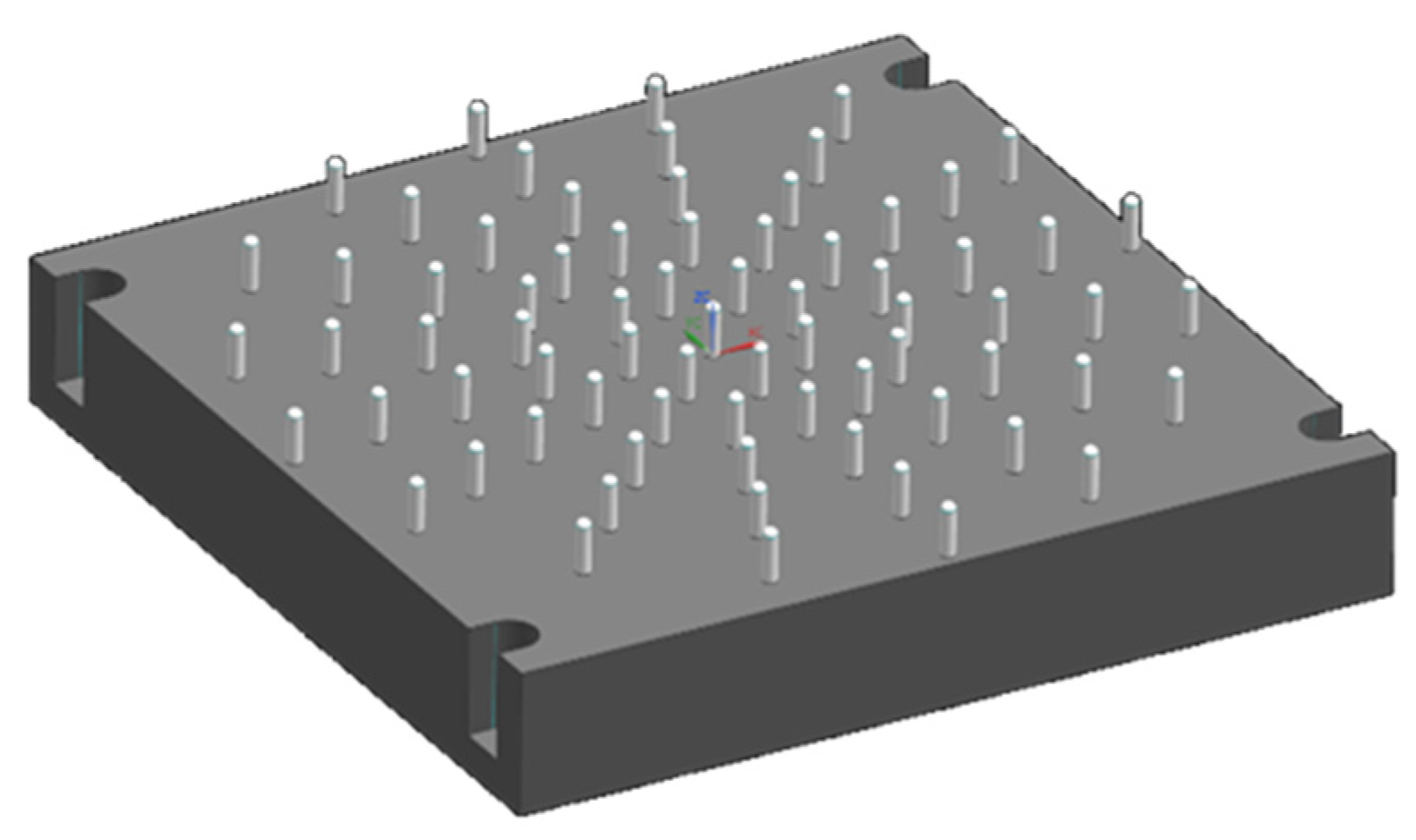
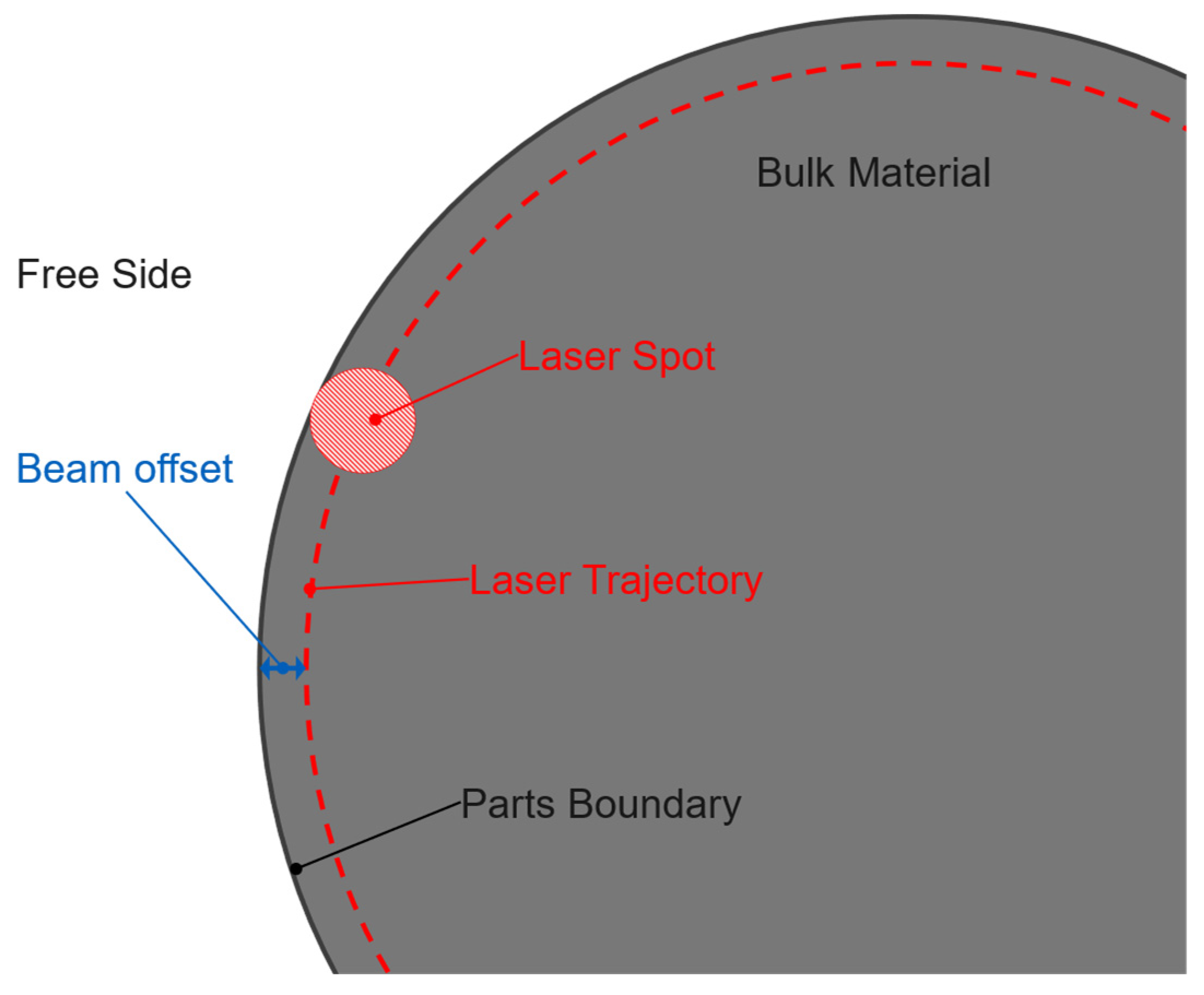
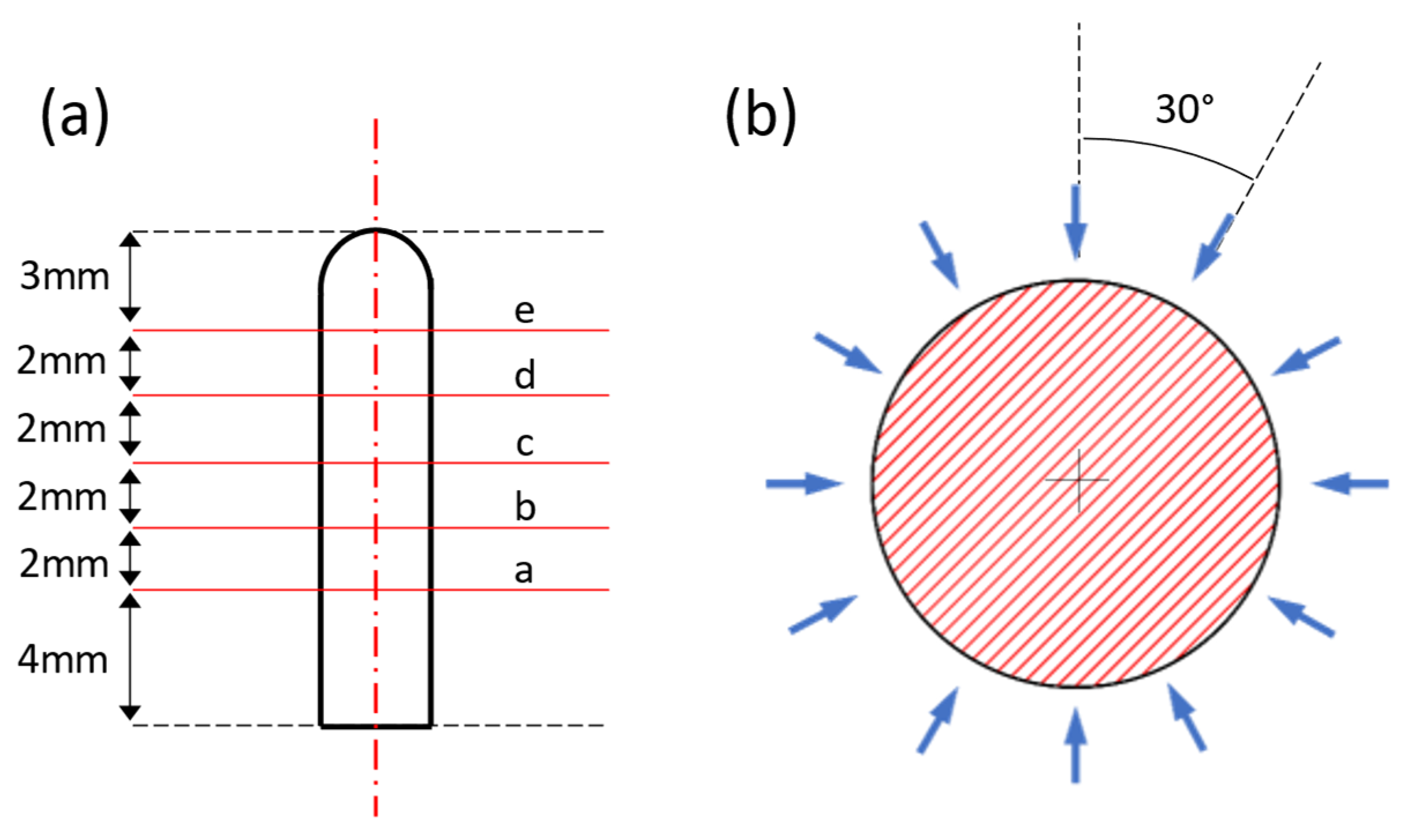
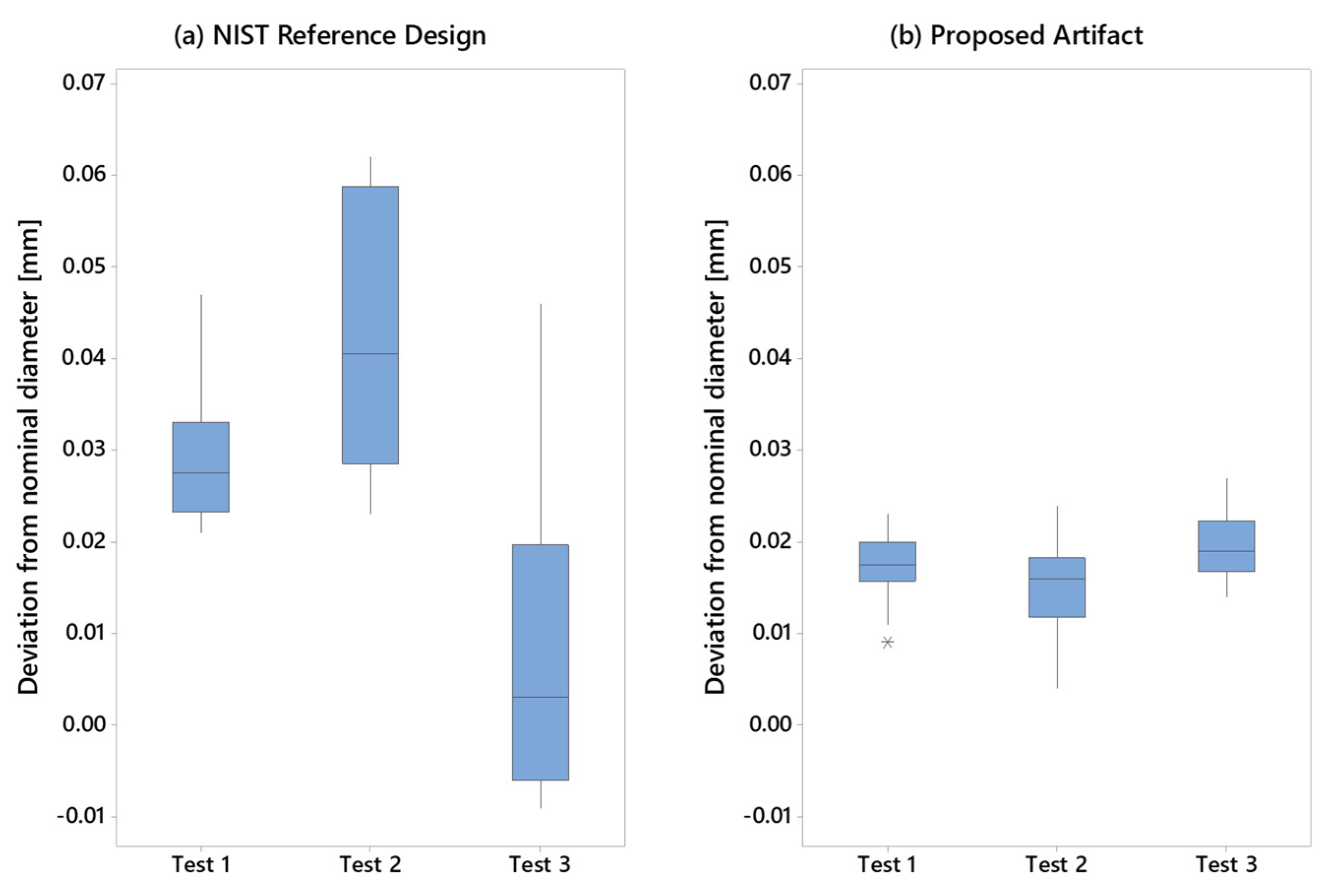
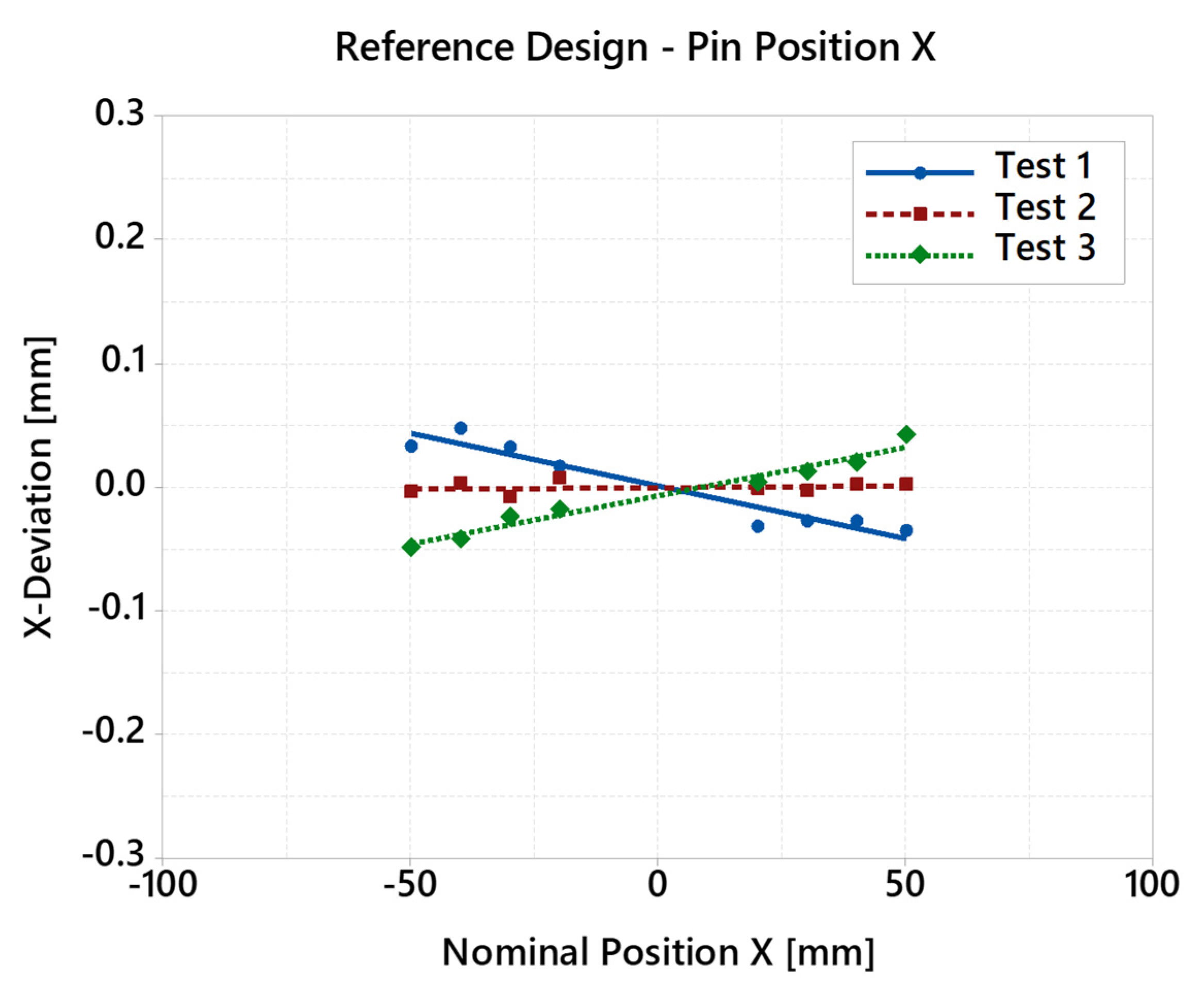

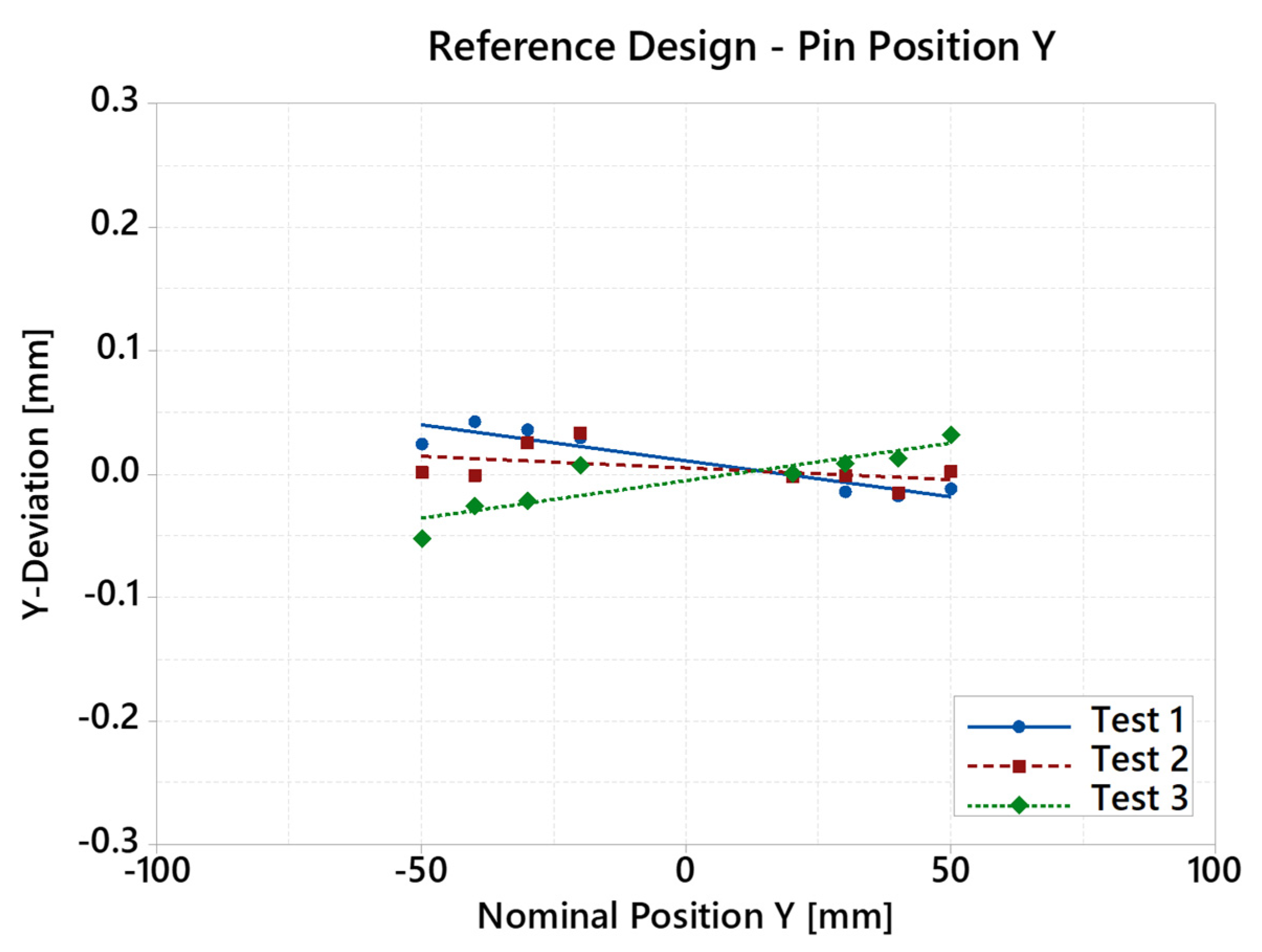
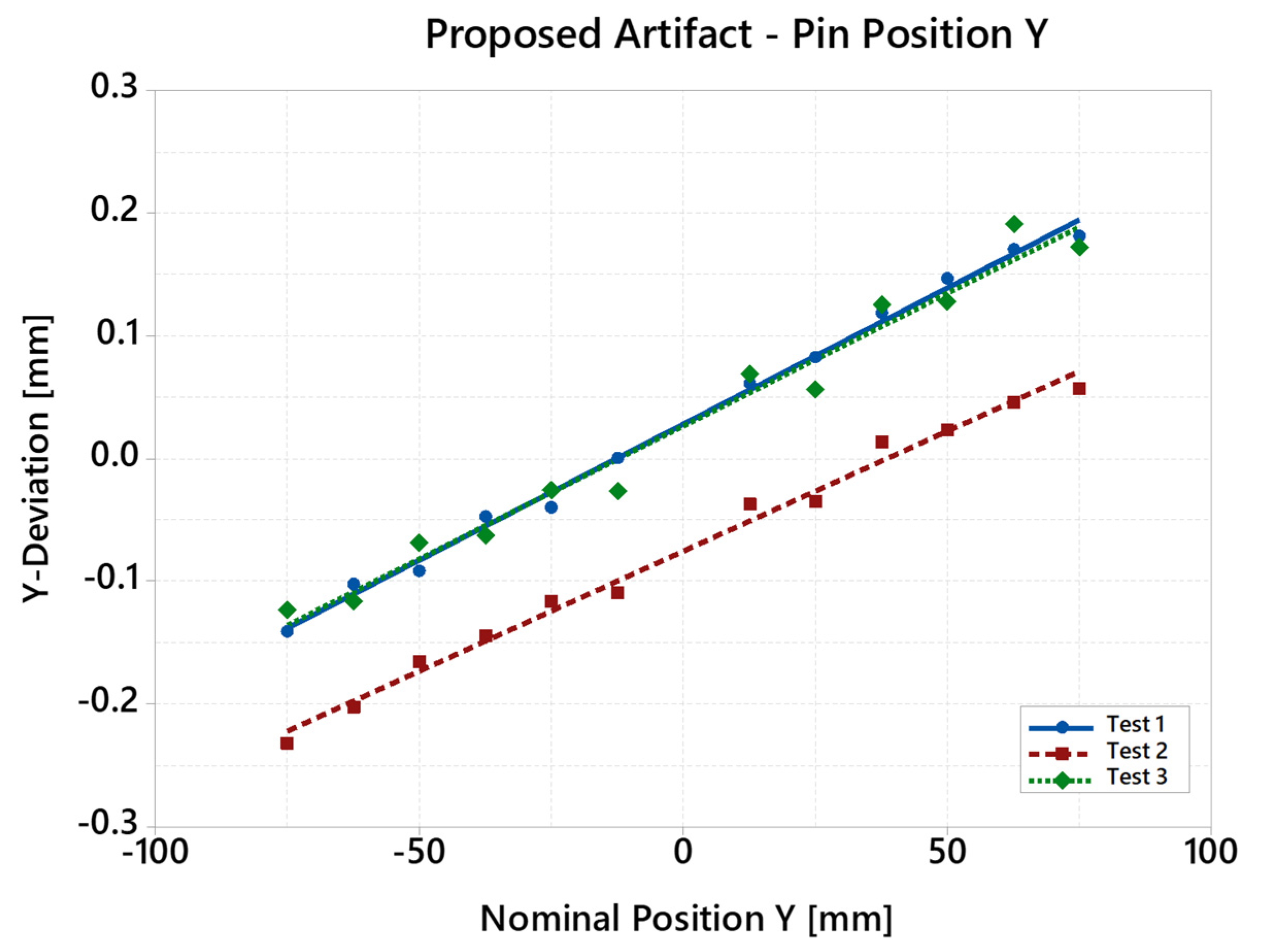
| FR | |
|---|---|
| 0 | Evaluate the performance of the system |
| 1 | Measure process precision |
| 2 | Measure shrinkage |
| 3 | Assess process capability |
| 4 | Measure roughness |
| DP | |
|---|---|
| 0 | Test artifact with multiple different geometric features |
| 1 | Pins |
| 2 | Central cylinders |
| 3 | Holes |
| 4 | Bulk material |
| 5 | Lateral features |
| 6 | Fine features |
| 7 | Staircase features |
| 8 | Ramp features |
| 9 | Flat top plane |
| FR | |
|---|---|
| 0 | Check PBF-LM machine capabilities |
| 1 | Produce the test artifact in less than 8 h |
| 1.1 | Print the artifact |
| 1.2 | Maximize printing uptime |
| 2 | Analyze the test artifact in less than 12 h |
| 2.1 | Use only one measuring system |
| 2.2 | Use an available measure system |
| 3 | Deliver results with measure accuracy below 10 microns in the whole working space |
| 3.1 | Choose only meaningful parameters |
| 3.2 | Make features independent from each other |
| 3.3 | Make measures independent from shrinkages effect |
| 3.4 | Analyze the whole working space |
| DP | |
|---|---|
| 0 | Test artifact of distributed identical features |
| 1 | Machine utilization time |
| 1.1 | Artifact volume |
| 1.2 | Geometrical complexity of the artifact |
| 2 | Time for the analysis |
| 2.1 | Measure obtainable through CMM * |
| 2.2 | Dedicated machine for performance check |
| 3 | Inspection plan |
| 3.1 | Measure beam offset compensation and laser positioning only |
| 3.2 | Single features printed above the building platform |
| 3.3 | Features thickness less than 5 mm |
| 3.4 | Spread features above the whole building platform |
| Laser Power (W) | 250 |
| Scanning Speed (mm/s) | 1000 |
| Hatch Distance (mm) | 0.09 |
| Δ⌀ | Test 1 [mm] | Test 2 [mm] | Test 3 [mm] |
|---|---|---|---|
| 1X | 0.023 | 0.027 | −0.005 |
| 2X | 0.040 | 0.031 | 0.016 |
| 3X | 0.022 | 0.023 | −0.008 |
| 4X | 0.024 | 0.028 | −0.006 |
| 5X | 0.022 | 0.057 | 0.008 |
| 6X | 0.024 | 0.044 | 0.004 |
| 7X | 0.021 | 0.037 | −0.009 |
| 8X | 0.031 | 0.059 | −0.006 |
| 1Y | 0.047 | 0.062 | 0.044 |
| 2Y | 0.033 | 0.061 | 0.046 |
| 3Y | 0.033 | 0.061 | 0.025 |
| 4Y | 0.024 | 0.058 | 0.021 |
| 5Y | 0.027 | 0.046 | −0.006 |
| 6Y | 0.032 | 0.031 | 0.002 |
| 7Y | 0.028 | 0.028 | −0.005 |
| 8Y | 0.033 | 0.030 | 0.006 |
| MEAN | 0.029 | 0.043 | 0.008 |
| SD | 0.007 | 0.015 | 0.018 |
| Δ⌀ | Test 1 [mm] | Test 2 [mm] | Test 3 [mm] |
|---|---|---|---|
| 1 | 0.014 | 0.004 | 0.014 |
| 2 | 0.017 | 0.012 | 0.016 |
| 3 | 0.011 | 0.009 | 0.017 |
| 4 | 0.023 | 0.024 | 0.027 |
| 5 | 0.019 | 0.018 | 0.019 |
| 6 | 0.020 | 0.020 | 0.015 |
| 7 | 0.021 | 0.018 | 0.017 |
| 8 | 0.017 | 0.016 | 0.019 |
| 9 | 0.017 | 0.010 | 0.017 |
| 10 | 0.019 | 0.012 | 0.017 |
| 11 | 0.016 | 0.011 | 0.019 |
| 12 | 0.009 | 0.009 | 0.014 |
| 13 | 0.011 | 0.012 | 0.016 |
| 14 | 0.021 | 0.015 | 0.020 |
| 15 | 0.015 | 0.016 | 0.022 |
| 16 | 0.020 | 0.023 | 0.023 |
| 17 | 0.016 | 0.024 | 0.019 |
| 18 | 0.021 | 0.018 | 0.024 |
| 19 | 0.019 | 0.016 | 0.022 |
| 20 | 0.018 | 0.014 | 0.026 |
| 21 | 0.017 | 0.016 | 0.025 |
| 22 | 0.018 | 0.019 | 0.021 |
| MEAN | 0.017 | 0.015 | 0.019 |
| SD | 0.004 | 0.005 | 0.004 |
| Nominal Position [mm] | Test 1 [mm] | Test 2 [mm] | Test 3 [mm] | |
|---|---|---|---|---|
| Pin 1X | −50 | 0.033 | −0.004 | −0.049 |
| Pin 2X | −40 | 0.047 | 0.003 | −0.042 |
| Pin 3X | −30 | 0.032 | −0.008 | −0.024 |
| Pin 4X | −20 | 0.017 | 0.007 | −0.018 |
| Pin 5X | 20 | −0.032 | −0.001 | 0.004 |
| Pin 6X | 30 | −0.028 | −0.003 | 0.012 |
| Pin 7X | 40 | −0.028 | 0.002 | 0.020 |
| Pin 8X | 50 | −0.035 | 0.002 | 0.042 |
| Pin 1Y | −50 | 0.024 | 0.001 | −0.052 |
| Pin 2Y | −40 | 0.042 | −0.001 | −0.026 |
| Pin 3Y | −30 | 0.036 | 0.025 | −0.022 |
| Pin 4Y | −20 | 0.029 | 0.033 | 0.007 |
| Pin 5Y | 20 | 0.000 | −0.002 | 0.000 |
| Pin 6Y | 30 | −0.014 | −0.001 | 0.009 |
| Pin 7Y | 40 | −0.018 | −0.015 | 0.013 |
| Pin 8Y | 50 | −0.012 | 0.002 | 0.032 |
| Nominal Position [mm] | Test 1 [mm] | Test 2 [mm] | Test 3 [mm] | |
|---|---|---|---|---|
| Pin 1X | −75 | −0.097 | −0.016 | −0.103 |
| Pin 2X | −62.5 | −0.075 | −0.002 | −0.063 |
| Pin 3X | −50 | −0.063 | 0.000 | −0.074 |
| Pin 4X | −37.5 | −0.045 | 0.035 | −0.039 |
| Pin 5X | −25 | −0.019 | 0.043 | −0.040 |
| Pin 6X | −12.5 | −0.013 | 0.057 | −0.015 |
| Pin 7X | 12.5 | 0.031 | 0.090 | 0.009 |
| Pin 8X | 25 | 0.028 | 0.105 | 0.030 |
| Pin 9X | 37.5 | 0.071 | 0.131 | 0.045 |
| Pin 10X | 50 | 0.072 | 0.139 | 0.085 |
| Pin 11X | 62.5 | 0.084 | 0.141 | 0.080 |
| Pin 12X | 75 | 0.087 | 0.154 | 0.107 |
| Pin 1Y | −75 | −0.141 | −0.233 | −0.124 |
| Pin 2Y | −62.5 | −0.103 | −0.203 | −0.117 |
| Pin 3Y | −50 | −0.092 | −0.166 | −0.069 |
| Pin 4Y | −37.5 | −0.048 | −0.145 | −0.063 |
| Pin 5Y | −25 | −0.040 | −0.117 | −0.026 |
| Pin 6Y | −12.5 | 0.000 | −0.110 | −0.027 |
| Pin 7Y | 12.5 | 0.061 | −0.038 | 0.068 |
| Pin 8Y | 25 | 0.082 | −0.035 | 0.056 |
| Pin 9Y | 37.5 | 0.118 | 0.013 | 0.125 |
| Pin 10Y | 50 | 0.146 | 0.023 | 0.127 |
| Pin 11Y | 62.5 | 0.170 | 0.045 | 0.191 |
| Pin 12Y | 75 | 0.181 | 0.057 | 0.172 |
| Coefficient | R-Sq (Adj) | ||
|---|---|---|---|
| Reference Artifact | Test 1 | −0.0009 | 91.4% |
| Test 2 | 0.0000 | 0% | |
| Test 3 | 0.0008 | 96% | |
| Proposed Artifact | Test 1 | 0.0013 | 98.1% |
| Test 2 | 0.0012 | 98.5% | |
| Test 3 | 0.0013 | 97.7% |
| Coefficient | R-Sq (Adj) | ||
|---|---|---|---|
| Reference Artifact | Test 1 | −0.0006 | 84.9% |
| Test 2 | −0.0002 | 8.1% | |
| Test 3 | 0.0006 | 76.1% | |
| Proposed Artifact | Test 1 | 0.0022 | 99.5% |
| Test 2 | 0.0020 | 99.0% | |
| Test 3 | 0.0022 | 97.2% |
Disclaimer/Publisher’s Note: The statements, opinions and data contained in all publications are solely those of the individual author(s) and contributor(s) and not of MDPI and/or the editor(s). MDPI and/or the editor(s) disclaim responsibility for any injury to people or property resulting from any ideas, methods, instructions or products referred to in the content. |
© 2024 by the authors. Licensee MDPI, Basel, Switzerland. This article is an open access article distributed under the terms and conditions of the Creative Commons Attribution (CC BY) license (https://creativecommons.org/licenses/by/4.0/).
Share and Cite
Giorgetti, A.; Ceccanti, F.; Baldi, N.; Kemble, S.; Arcidiacono, G.; Citti, P. Axiomatic Design of a Test Artifact for PBF-LM Machine Capability Monitoring. Machines 2024, 12, 199. https://doi.org/10.3390/machines12030199
Giorgetti A, Ceccanti F, Baldi N, Kemble S, Arcidiacono G, Citti P. Axiomatic Design of a Test Artifact for PBF-LM Machine Capability Monitoring. Machines. 2024; 12(3):199. https://doi.org/10.3390/machines12030199
Chicago/Turabian StyleGiorgetti, Alessandro, Filippo Ceccanti, Niccolò Baldi, Simon Kemble, Gabriele Arcidiacono, and Paolo Citti. 2024. "Axiomatic Design of a Test Artifact for PBF-LM Machine Capability Monitoring" Machines 12, no. 3: 199. https://doi.org/10.3390/machines12030199








